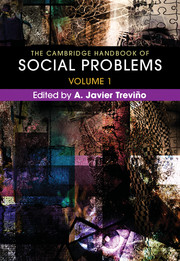Book contents
- The Cambridge Handbook of Social Problems
- The Cambridge Handbook of Social Problems
- Copyright page
- Contents
- About the Contributors
- Introduction
- Part I General Concerns and Orientations in the Study of Social Problems
- Part II Historical and Theoretical Issues in the Study of Social Problems
- Chapter 11 Settlement Sociology
- Chapter 12 Chicago School: City as a Social Laboratory
- Chapter 13 Luhmann's Sociological Systems Theory and the Study of Social Problems
- Chapter 14 The Conflict Approach
- Chapter 15 Radical Interactionism and the Symbolism of Methamphetamine
- Chapter 16 Social Constructionism
- Part III Problems of Discrimination and Inequality
- Part IV Problems of Institutions
- Index
- References
Chapter 15 - Radical Interactionism and the Symbolism of Methamphetamine
from Part II - Historical and Theoretical Issues in the Study of Social Problems
Published online by Cambridge University Press: 16 March 2018
- The Cambridge Handbook of Social Problems
- The Cambridge Handbook of Social Problems
- Copyright page
- Contents
- About the Contributors
- Introduction
- Part I General Concerns and Orientations in the Study of Social Problems
- Part II Historical and Theoretical Issues in the Study of Social Problems
- Chapter 11 Settlement Sociology
- Chapter 12 Chicago School: City as a Social Laboratory
- Chapter 13 Luhmann's Sociological Systems Theory and the Study of Social Problems
- Chapter 14 The Conflict Approach
- Chapter 15 Radical Interactionism and the Symbolism of Methamphetamine
- Chapter 16 Social Constructionism
- Part III Problems of Discrimination and Inequality
- Part IV Problems of Institutions
- Index
- References
Summary
This chapter provides a radical symbolic interactionist interpretation and analysis of the television series, Breaking Bad and its representation of a deviant innovator, Walter White, and the crystal methamphetamine he cooks. Using the central concepts of radical symbolic interaction, domination, and specifying its four themes related to categorical identification and competence, partnership, emergence, and self-objectification, I characterize White as one who seeks domination in methamphetamine worlds and discuss methamphetamine as an object defined through the prism of attaining status. While acknowledging methamphetamine as a powerful drug in regard to ingestion, I also characterize it as an inanimate thing that becomes meaningful in regard to specific responses to it. White's particular brand, blue crystal methamphetamine, becomes significant not so much as a powerful drug ingested but as a drug representing purity in the methamphetamine world through which White navigates. Furthermore, methamphetamine in Breaking Bad gains meaning as linked, specifically, to White's persona, Heisenberg. In the above light, I link particular scenes to the themes of domination, concluding with brief analogies to other worlds in which deviance or at least being noticeably different relates to domination specifically.
- Type
- Chapter
- Information
- The Cambridge Handbook of Social Problems , pp. 259 - 278Publisher: Cambridge University PressPrint publication year: 2018
References
- 3
- Cited by



